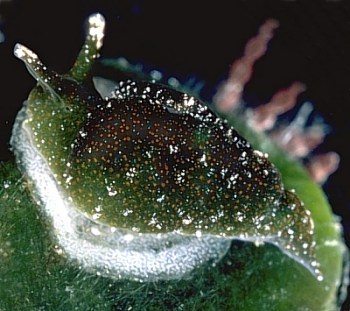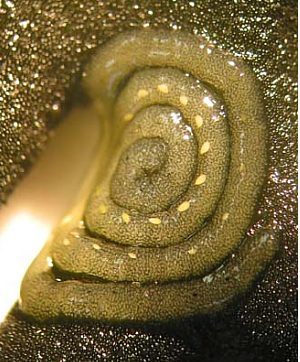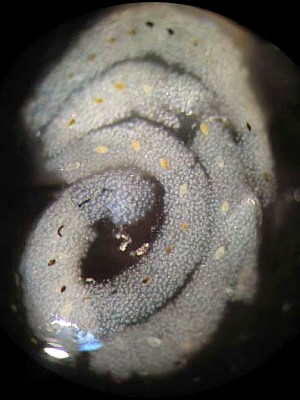
Elysia maoria
Powell, 1937
Order: SACOGLOSSA
Superfamily: ELYSIOIDEA
Family: Elysiidae
DISTRIBUTION
New Zealand and southeastern Australia.
PHOTO
Adult on egg ribbon, on Codium. Two-Fold Bay, southern New South Wales, March 1986. PHOTO: Bill Rudman.
Grows to about 25mm. Found throughout the year on Codium, this predominantly green species gets its colouration from the Codium chloroplasts in the fine branching ducts of the digestive system. Its reproductive system and mating behaviour have been exhaustively studied in New Zealand (Reid, 1964). It mates by hypodermic insemination, depositing sperm by piercing the body wall of its partner. In most cases the penis pierces the body wall at the posterior end of the parapodia, usually on the right side. How it pierces the body wall is unknown, because unlike other sacoglossans which practice hypodermic insemination, it does not have a penial stylet.
Reference:
• Reid, J.D. (1964) The reproduction of the ascoglossan opisthobranch Elysia maoria. Proceedings of the Zoological Society, London, 143(3): 365-393.
Rudman, W.B., 2000 (April 8) Elysia maoria Powell, 1937. [In] Sea Slug Forum. Australian Museum, Sydney. Available from http://www.seaslugforum.net/find/elysmaor
Related messages
Re: Elysia maoria(?) and egg masses
April 9, 2003
From: Kathe R. Jensen
Dear Rachel & Bill,
As you mention, there seems to be 2 types of "extra-capsular yolk" in sacoglossans: the superficial "blobs", which are also found in Elysia obtusa and I think in E. atroviridis and possibly most species of Bosellia. Unfortunately we do not know where either of the 2 types of "yolk" are produced. I think this would be a nice research topic for a student of micro-anatomy and histology. Most likely these superficial blobs are produced in the distal part of the mucus gland (which should not be spelt mucous though it is slimy (mucous) as well as slime- (mucus-)producing), and the internal band-like yolk is produced in some more central part of the reproductive system.
I cannot explain why the yolk-dots are black towards both ends of the egg mass.
I checked the picture of the Thuridilla vatae egg mass and I don't think that it has superficial spots of yolk. In Thuridilla the eggs are also coloured red or orange.
Best wishes,
Kathe
krjensen@zmuc.ku.dk
Thanks Kathe,
I wondered whether the large spots in the Thuridilla vatae egg mass were eggs or these 'superficial blobs' [what a wonderful scientific term] and decided that if they were eggs they were extremely large. Do you know if it is a direct developer? Any photos of eggs with peculiar 'yolk' would be very welcome.
Best wishes,
Bill Rudman
Elysia maoria(?) and egg masses
April 8, 2003
From: Rachel Przeslawski

Hi Bill,
I recently collected a bunch of Codium with these Elysia species (E. maoria?) all over it. When brought back to the lab they laid several of these odd looking egg masses which seem identical to the one we looked at when you were last at University of Wollongong. They're normal sacoglossan flattened spirals, but they have what appear to be evenly spaced yolk granules on top of the mass. This isn't too unusual as Boucher (1983) has documented this before. What's odd is that some of the yolk granules appear to be smaller and completely black; these could be a completely different structure than the yolk, but I just can't imagine what! Any ideas?
Thanks!
Rachel
rachelp@uow.edu.au



Thanks Rachel,
Yes this is the egg mass we looked at previously. I suspected it was that of Elysia maoria, but at that time we didn't have an animal to confirm the identification. Concerning the mystery 'yolk' objects. I thought I had seen them before. They were described by Jocelyn Reid (1964) in her study of E. maoria in New Zealand. Although she gives a detailed description of the workings of the reproductive system, she doesn't say much about the mystery objects - just calls them 'pockets of granular secretion'. They don't look like the extra-capsular yolk which some opisthobranchs produce, and which has been reviewed, as you mention, by Boucher (1983). Extra-capsular yolk is usually in streaks, or a long string, outside the egg capsule, but within the envelope of the egg ribbon - presumably so it's accessible to the developing larvae. In this egg ribbon the 'yolk' capsules seem to be outside the layer enclosing the egg ribbon.
A similar egg ribbon has been reported in a few other sacoglossans. There are photos in the Forum of the egg ribbon of Elysia gordanae and Thuridilla vatae with identical strutures, and Ortea, Luque & Templado (1988) describe similar egg ribbons from the Canary Ids for Thuridilla picta and Bosellia leve. They identify it as extra-capsular yolk. Species of Thuridilla are all thought to have extra-capsular yolk [see Kathe Jensen's message] but as I say above, in some instances it is an internal thread. It would be interesting to have other observations and thoughts on this.
• Boucher, L. M. (1983) Extra-capsular yolk bodies in the egg masses of some tropical Opisthobranchia. Journal of Molluscan Studies, 49(3): 232-241.
• Ortea, J.A., Luque, A.A. & Templado, J. (1988) Elysia picta Verrill, 1901, and Geitodoris pusae (Marcus, 1955), two amphiatlantic opisthobranch gastropods. J. Moll. Stud., 54: 243-247.
• Reid, J.D. (1964) The reproduction of the ascoglossan opisthobranch Elysia maoria. Proceedings of the Zoological Society, London, 143(3): 365-393.
Best wishes,
Bill Rudman
Camouflaged sea slug from Sydney
April 9, 2000
From: Robyn Stevens
Dear Bill,
I have found some tiny (2cm long) sea slugs in about 3m water off Sydney and I would love to know what they are.
They are dark green, with white antennae, 2 flaps of mantle that almost meet along the top (like a sea hare),and 3 white dots along the top margin of the flaps. They are eating the large dark green algae (Codium duthiae / galeatum?) which is in my fish tank. They are perfectly matched colourwise and tend to sit in the U-shaped bends in the algae making them difficult to find.
Also, I'd love some hints on how to photograph them. Are the amazing photos on your site taken with underwater cameras?
Thanks for your time,
Robyn
robyn_s1@yahoo.com
Stevens, R., 2000 (Apr 9) Camouflaged sea slug from Sydney. [Message in] Sea Slug Forum. Australian Museum, Sydney. Available from http://www.seaslugforum.net/find/2237Dear Robyn,
I am pretty sure your animal is Elysia maoria. It belongs to a group of sea-slugs called sacoglossans which are all herbivores, different species feeding on different species of algae. Another species found on the same species of Codium as Elysia maoria is Placida dendritica. Have a look at the page on that species to find out about the amazing ability of some sacoglossans to keep plant organelles alive and photosynthesising in their own bodies.
For a further idea of diversity in the sacoglossans go to the Species List and look at any of the species listed in the Order Sacoglossa.
The short answer to your question about photographs is that most are taken in special dishes and aquaria I have made so I can control the lighting and background etc. It requires very clean glass and very clean water, but for microscopic and intertidal animals there are no easy alternatives. I have had quite a few inquiries about photography, and I have been meaning to prepare a page on the subject. With luck I will get around to it soon.
Best wishes,
Bill Rudman.
